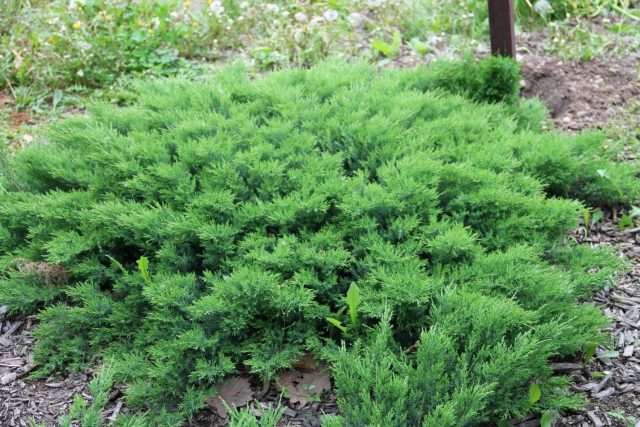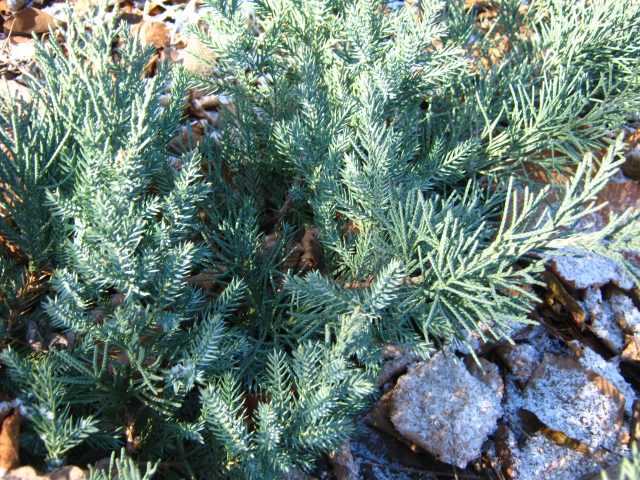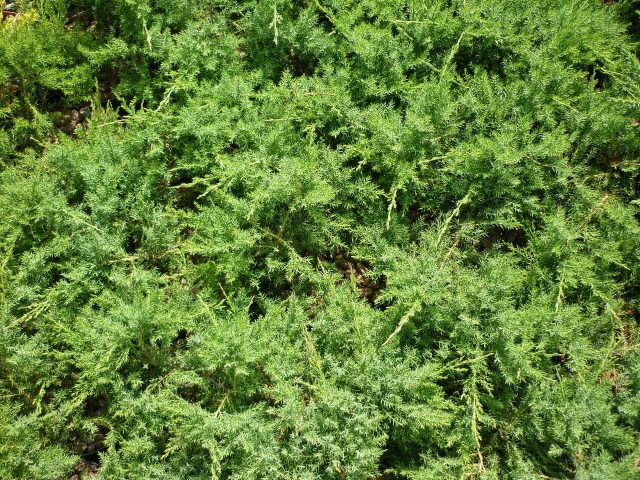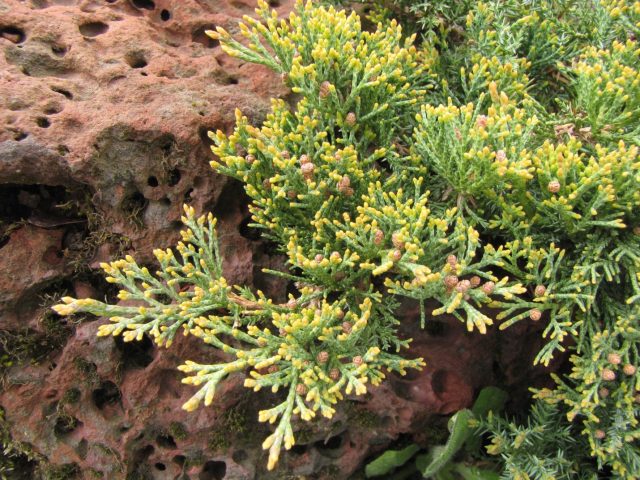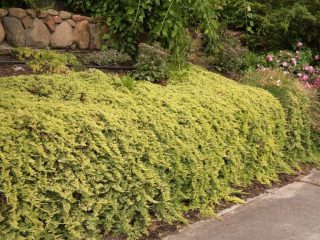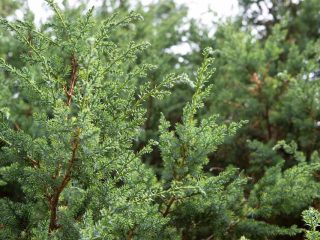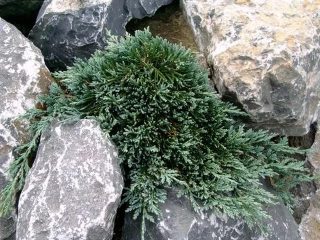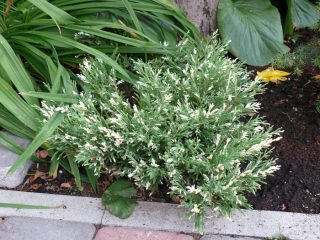Content
Daurian juniper (stone heather) is an evergreen plant belonging to the Cypress family. In its natural habitat, it grows on mountain slopes, coastal rocks, dunes, near rivers. Distribution area in Russia: Far East, Yakutia, Amur region, Transbaikalia.
Botanical description of Daurian juniper
Stone heather is a low-growing shrub with creeping branches, growing no higher than 0.5 m. The central trunk of the plant is hidden in the ground, visually the stems are formed from the root, each shoot grows apart, like a separate plant.
The juniper grows slowly, when it reaches five years, it is considered an adult, during the year it gives a slight increase - up to 6 cm.A fully formed shrub reaches 50 cm in height, 1.2 m in width. In a young plant, shoots rise above the soil, forming a crown in the form of a round dome. Upon reaching 7 cm, the branches spread over the surface. The culture belongs to the ground cover species, therefore, shoots in contact with the ground take root.
After 5 years of vegetation, the growth does not exceed 1 cm per year. Juniper Daurian - a perennial culture can grow on one site for more than 50 years. The decorativeness of the shrub and its unpretentious care is used by designers to decorate the landscape. Juniper is a frost-resistant and heat-resistant plant that does not water for a long time. In partially shaded areas, the vegetation does not slow down.
External description of the Daurian juniper shown in the photo:
- branches are thin, 3 cm in diameter at the base, tapering at the apex, completely stiff, gray in color, with an uneven bark prone to peeling;
- needles are light green, of two types: at the top of the shoot, scaly in the form of a rhombus, needle-like along the length of the branch, collected 2 pieces in whorls. The needles do not fall off for the winter, in the fall they change color to maroon;
- berries in the form of cones, round, up to 6 mm in diameter, color - dark gray with a brown tint, surface with a silvery bloom. They are formed in small quantities and not every year;
- juniper seeds are oblong oval, their fruits contain 2–4 pieces;
- the root system is superficial, growing to the sides by 30 cm.
The chemical composition of the culture contains essential oils and a number of trace elements. The plant is used as a flavoring agent for alcoholic beverages and cosmetic products.
Daurian juniper in landscape design
Dahurian creeping juniper grows on any soil, even on salt marshes. A frost-resistant plant does not require special care. Expanding, it forms a dense covering of branches that visually resemble a lawn. The upper stems are partially adjacent to the lower ones, leaving no space.
The plant is not deciduous, it retains its decorative appearance throughout the year, the bright green carpet changes color to burgundy by autumn. It grows slowly, does not require constant crown formation and pruning.These features of juniper are used for landscaping flower beds near office buildings, decorating personal plots and park recreation areas.
Creeping crown, short stature, exotic habit, suitable for a ground cover design option. The culture is used in single and group compositions. Planted next to flowering shrubs to create a lower background. It is used as a green accent in the following cases:
- to create the side and central part of the rock garden, when the juniper located on top descends the slope in a cascade;
- a shrub planted in rockeries near the central stones is an imitation of a lawn;
- in order to decorate the shores of a small artificial reservoir;
- on flower beds and ridges, juniper grows in a solid mass, under which there is no weeds, is the lower background for flowering crops;
- for the decoration of curbs and rocky slopes on the site or in the park.
Daurian juniper can be found on loggias, cornices or the roof of a building. The plant is preliminarily grown in pots or purchased for adults.
Dahurian juniper varieties
Juniper comes in two varieties. They differ in the shape of the needles and the color of the crown. They grow in the wild in the same climatic zones as stone heather, but are less common than the classic type of Daurian juniper. Varieties are often used in the design of the territory.
Juniper Daurian Leningrad
A variety of culture, the Daurian juniper variety leningrad ("Leningrad") is a dwarf shrub up to 45 cm tall. The branches creeping along the surface reach a length of 2 m. The young plant forms a pillow-like crown, the grown shoots sink to the surface. At the point of contact with the ground, the juniper forms a root.
The needles of the variety are dense, small needles fit tightly to the stem of the shoots. The color is light green with a clear blue tint. The crown of the bush is quite prickly. A representative of the species grows well on loams and neutral soils. Until the age of five, it gives an increase of 7 cm per year, after the growing season it slows down slightly, the bush grows by 5 cm per season.
The plant prefers open areas, responds well to sprinkling. Juniper "Leningrad" is used for decoration of rock gardens, rabatok, borders. In a group composition, they are planted with Erica, undersized pine, roses, tall forms of heather.
Juniper Daurian Expansa variegata
The horizontal dahurian juniper "Expansa Variegata" is the most decorative representative of its kind. A shrub with straight branches, the lower ones are tightly pressed to the surface, the subsequent ones are located on top, it is almost impossible to disassemble the weave.
The bush grows up to 45 cm in height. The maximum crown size is 2.5 m. Daurian juniper "Variegata" is characterized by a two-color color: needles are blue with a light green tint, the main part of the branches with cream-colored scaly needles. The chemical composition of the shrub contains a high concentration of essential oils.
The variety grows on all soil compositions, frost-resistant, heat-resistant. Used for landscaping sanitary zones in parks, on alpine slides. They are planted in flower beds and flower beds as a ground cover plant.
Planting Daurian juniper
The best site for planting Daurian juniper is the southern side of the slope, open country or partial shade. In the shade of trees with a dense crown, the plant stretches, the needles become smaller, grows poorly. Excess moisture remains under the dwarf bush, and dry fragments can be observed on the branches. The composition of the soil is neutral or slightly alkaline. A prerequisite is drained, light, loose soil. It is not recommended to plant junipers near fruit trees, as it is not recommended.there is a risk of infection (leaf rust).
Seedling and planting plot preparation
You can propagate a juniper with a purchased seedling, self-harvested planting material, or by transferring an adult plant to another site. Work is carried out in the spring, approximately in April or autumn, before the onset of frost. A seedling for planting must meet the requirements:
- the root must be whole, without areas of drying out or decay;
- needles must be present on the branches.
If an adult plant is transplanted to another place, the transfer scheme must be followed:
- The branches are lifted from the ground to a vertical position.
- Gather in a bunch, wrap it with a cloth, fix it with a rope, but it is not recommended to tighten the crown tightly.
- They dig in the bush, retreating from the center 0.35 m, deepening by about 30 cm.
- The juniper is removed along with the soil lump.
Placed on oilcloth or burlap, remove excess soil from the root.
Before placing the plant in a specific place for it, prepare a site:
- They dig up the soil, remove weeds.
- A landing recess is made 60 cm, 15 cm wider than the root.
- The soil from the pit is mixed with peat and sand.
- Drainage is placed at the bottom, pebbles or crushed stone will do.
On average, the landing pit turns out to be 60 * 50 cm.
Landing rules
The root of the seedling is dipped in a growth stimulator for 2 hours. Dolomite flour is added to the mixture of soil, peat and sand at the rate of 100 g per 2 buckets. Juniper responds well to alkali. Landing Algorithm:
- 1/2 part of the mixture is poured onto the drainage of the planting hole.
- The seedling is placed in the center, the root is distributed.
- The rest of the soil is poured on top.
- The root circle is compacted and watered.
If an adult plant was transferred, the crown is freed from the tissue, the branches are distributed on the surface. Dahurian juniper is placed at intervals of 0.5 m.
Dahurian Juniper Care
The culture is undemanding in agricultural technology, care for a juniper consists in watering, forming a crown and removing weeds.
Watering and feeding
For the growing season, the culture needs moderate moisture. Young seedlings are watered with a small amount of water every other day in the evening. The procedures are carried out within 60 days, provided that there is no precipitation. In hot weather, the whole bush is watered by sprinkling. The adult Daurian juniper does not need watering, the moisture remains under the crown cap for a long time. The culture is fed up to two years of age, once in April. Then no fertilizer is applied.
Mulching and loosening
After planting, the root circle of the juniper is covered with a layer (5-6 cm) of sawdust, needles or chopped bark. The mulch is renewed every fall. They loosen the soil and remove weeds near young plantings. For an adult bush, weeding is not relevant, the weed does not grow under a dense layer of branches, and the mulch retains moisture and passes oxygen well.
Trimming and shaping
Pruning of Dahurian juniper is done in spring, frozen branches and dry fragments are removed. If the plant has overwintered without loss, pruning is not required. A bush is formed in accordance with the design decision. The crown of the culture is decorative, it grows slowly, if necessary, the length of the branches is shortened, one formation per year is enough.
Preparing for winter
At the end of autumn, juniper is given water-charging irrigation. The layer of mulch is increased by 10 cm. Before the onset of frost, young shrubs are collected in a bunch of branches, carefully fixed. The measure is necessary so that the shoots do not break under the weight of the snow. Cover with spruce branches from above. You can install low arcs and stretch the covering material, in winter, throw snow on top. For an adult Daurian juniper, preparation for winter consists only in mulching.
Reproduction
The best way to propagate Dahurian juniper is by layering. A young shoot of a two-year growing season is used, fixed to the surface, covered with soil.The branch gives roots, after a year it can be planted.
Less commonly, the grafting method is used. The material is cut from the top of the three-year-old shoots. Can be propagated by vaccination. The material of Daurian juniper on a trunk of another species takes root in 40%, this method is rarely used.
Sowing seeds gives a plant with full characteristics of the parent variety, the growing process is lengthy, so it is rarely used.
Diseases and pests
Juniper Dahurian and its varieties secrete substances that are toxic to most garden pests. The plant can be parasitized:
- Aphid. They get rid of it by destroying ants, cut and remove branches where the bulk of aphids have accumulated.
- Sawfly. The larvae are harvested by hand, the plant is sprayed with Karbofos.
- Shield. Treat with a solution of laundry soap. They create constant crown moisture, the pest does not tolerate excess moisture well. If the scabbard remains, the bushes are treated with insecticides.
- Spider mite. Eliminate the pest with colloidal sulfur.
Without the proximity of apple, pear and cherry trees, the plant does not get sick. If a fungal infection has struck a Dahurian juniper, it is treated with agents containing copper.
Conclusion
Daurian juniper is an evergreen dwarf ornamental shrub. A frost-resistant culture is undemanding to the composition of the soil; it can be in a sunny area for a long time without irrigation. It tolerates temporary shading well. They are planted as a ground cover plant on a personal plot, in city squares, recreation areas. Serves for the decoration of borders, flower beds, rockeries and rock gardens.
